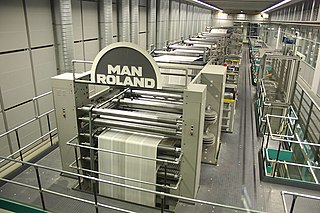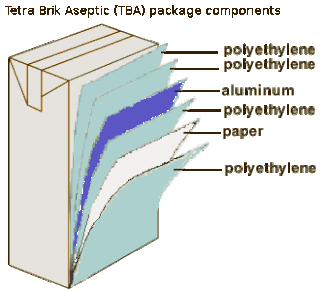Related Research Articles

Pulp is a lignocellulosic fibrous material prepared by chemically or mechanically separating cellulose fibers from wood, fiber crops, waste paper, or rags. Mixed with water and other chemical or plant-based additives, pulp is the major raw material used in papermaking and the industrial production of other paper products.

Business cards are cards bearing business information about a company or individual. They are shared during formal introductions as a convenience and a memory aid. A business card typically includes the giver's name, company or business affiliation and contact information such as street addresses, telephone number(s), fax number, e-mail addresses and website. Before the advent of electronic communication business cards might also include telex details. Now they may include social media addresses such as Facebook, LinkedIn and Twitter. Traditionally, many cards were simple black text on white stock, and the distinctive look and feel of cards printed from an engraved plate was a desirable sign of professionalism. In the late 20th century, technological advances drove changes in style, and today a professional business card will often include one or more aspects of striking visual design.

Paperboard is a thick paper-based material. While there is no rigid differentiation between paper and paperboard, paperboard is generally thicker than paper and has certain superior attributes such as foldability and rigidity. According to ISO standards, paperboard is a paper with a grammage above 250 g/m2, but there are exceptions. Paperboard can be single- or multi-ply.

A paper machine is an industrial machine which is used in the pulp and paper industry to create paper in large quantities at high speed. Modern paper-making machines are based on the principles of the Fourdrinier Machine, which uses a moving woven mesh to create a continuous paper web by filtering out the fibres held in a paper stock and producing a continuously moving wet mat of fibre. This is dried in the machine to produce a strong paper web.

Offset printing is a common printing technique in which the inked image is transferred from a plate to a rubber blanket and then to the printing surface. When used in combination with the lithographic process, which is based on the repulsion of oil and water, the offset technique employs a flat (planographic) image carrier. Ink rollers transfer ink to the image areas of the image carrier, while a water roller applies a water-based film to the non-image areas.

Kraft paper or kraft is paper or paperboard (cardboard) produced from chemical pulp produced in the kraft process.

Tracing paper is paper made to have low opacity, allowing light to pass through. It was originally developed for architects and design engineers to create drawings which could be copied precisely using the diazo copy process; it then found many other uses. The original use for drawing and tracing was largely superseded by technologies which do not require diazo copying or manual copying of drawings.
Coated paper is paper that has been coated by a mixture of materials or a polymer to impart certain qualities to the paper, including weight, surface gloss, smoothness, or reduced ink absorbency. Various materials, including kaolinite, calcium carbonate, bentonite, and talc, can be used to coat paper for high-quality printing used in the packaging industry and in magazines.
The Sartell Paper Mill, officially the Verso Paper Sartell Mill, was a paper mill located in the city of Sartell in the U.S. state of Minnesota, operating from 1905 until a disastrous explosion in 2012.

Inkjet paper is a special fine paper designed for inkjet printers, typically classified by its weight, brightness and smoothness, and sometimes by its opacity.
In printing, anti-set-off spray powder is used to make an air gap between printed sheets of paper. This enables the ink to dry naturally and therefore avoid the unwanted transfer of ink from one printed sheet to another. The problem can occur with most types of printing.
Printing and writing papers are paper grades used for newspapers, magazines, catalogs, books, notebooks, commercial printing, business forms, stationeries, copying and digital printing. About 1/3 of the total pulp and paper marked is printing and writing papers. The pulp or fibers used in printing and writing papers are extracted from wood using a chemical or mechanical process.

Paper is a thin sheet material produced by mechanically or chemically processing cellulose fibres derived from wood, rags, grasses or other vegetable sources in water, draining the water through fine mesh leaving the fibre evenly distributed on the surface, followed by pressing and drying. Although paper was originally made in single sheets by hand, almost all is now made on large machines—some making reels 10 metres wide, running at 2,000 metres per minute and up to 600,000 tonnes a year. It is a versatile material with many uses, including printing, packaging, decorating, writing, cleaning, filter paper, wallpaper, book endpaper, conservation paper, laminated worktops, toilet tissue, currency and security paper and a number of industrial and construction processes.
Deinking is the industrial process of removing printing ink from paperfibers of recycled paper to make deinked pulp.

Liquid packaging board is a multi-ply paperboard with high stiffness, strong wet sizing and a high barrier coating, e.g. plastic. Only virgin paper fibers are used. The barrier coating must hold the liquid and prevent migration of air and flavors through the paperboard.
Woodfree uncoated paper (WFU), uncoated woodfree paper (UWF) or uncoated fine papers are manufactured using wood that has been processed into a chemical pulp that removes the lignin from the wood fibers and may also contain 5–25% fillers. Both softwood and hardwood chemical pulps are used and a minor part of mechanical pulp might be added. These paper grades are calendered.
Special fine paper is a classification of paper used for copying and digital printing.
Fine papers are printing and writing paper grades based mainly on chemical pulps. Normally the content of mechanical pulps are below 10% and the amount of fillers in the range 5–25%.
Stone Paper products, generically referred to as bio-plastic paper, mineral paper or rich mineral paper, are strong and durable paper-like material manufactured from calcium carbonate bonded with small amount of high-density polyethylene (HDPE) resin. They are used in many of the same applications as cellulose-based paper.

A paper sack is shipping container made of high quality and weight paper, usually kraft virgin fiber, which is normally used for transporting powder materials, such as flour, cement, animal feed, etc. Multi-wall paper bags usually have several layers of heavy duty kraft paper, sometimes with a highly printed paper on the outside. Plastic films and coated papers are sometimes used as inner layers to provide a moisture barrier, and resistance to rodents and insects.
References
- ↑ Parker, Amely. "Club Flyer Paper List". VIP Printing Marketing. Retrieved 21 June 2013.
Sources
- Paulapuro, Hannu, ed. (2000). Paper and Board Grades. Papermaking Science and Technology. 18. Helsinki, Finland: Fapet OY. ISBN 952-5216-18-7.
- "Paper Products List". Gould Publication Papers. Archived from the original on 8 November 2012. Retrieved 7 November 2012.